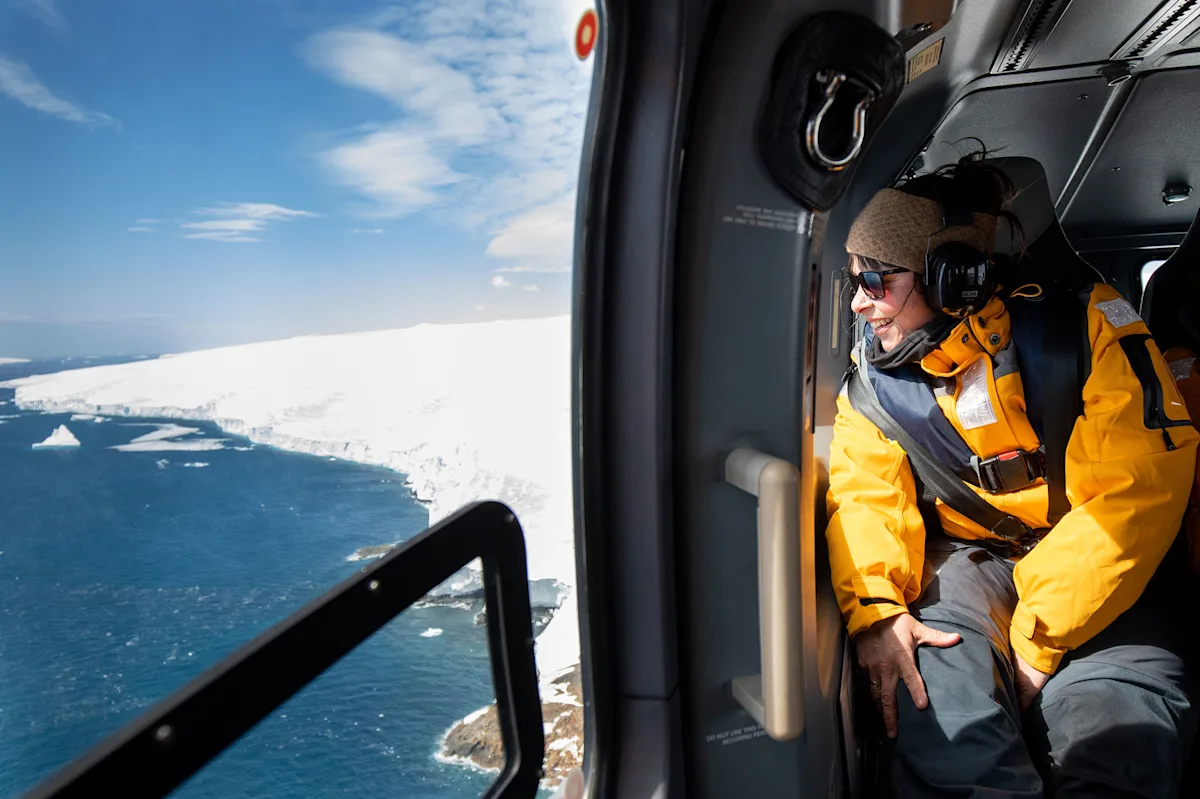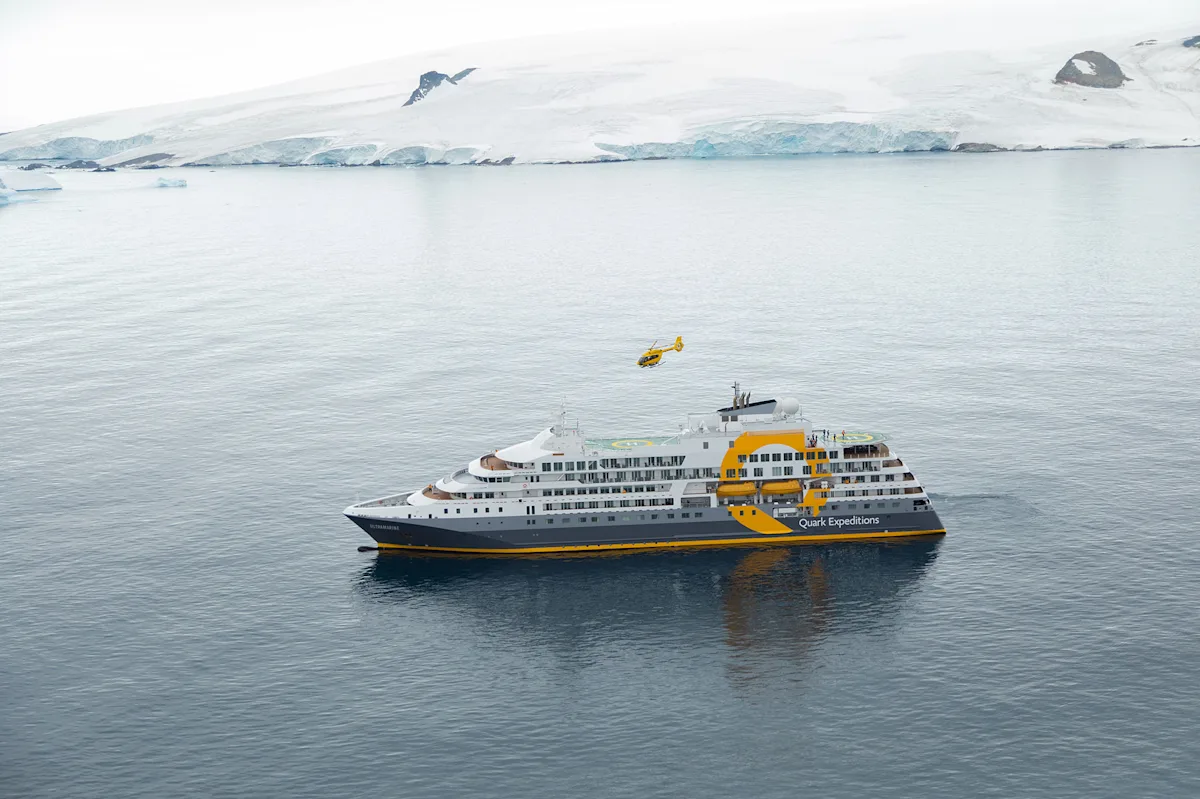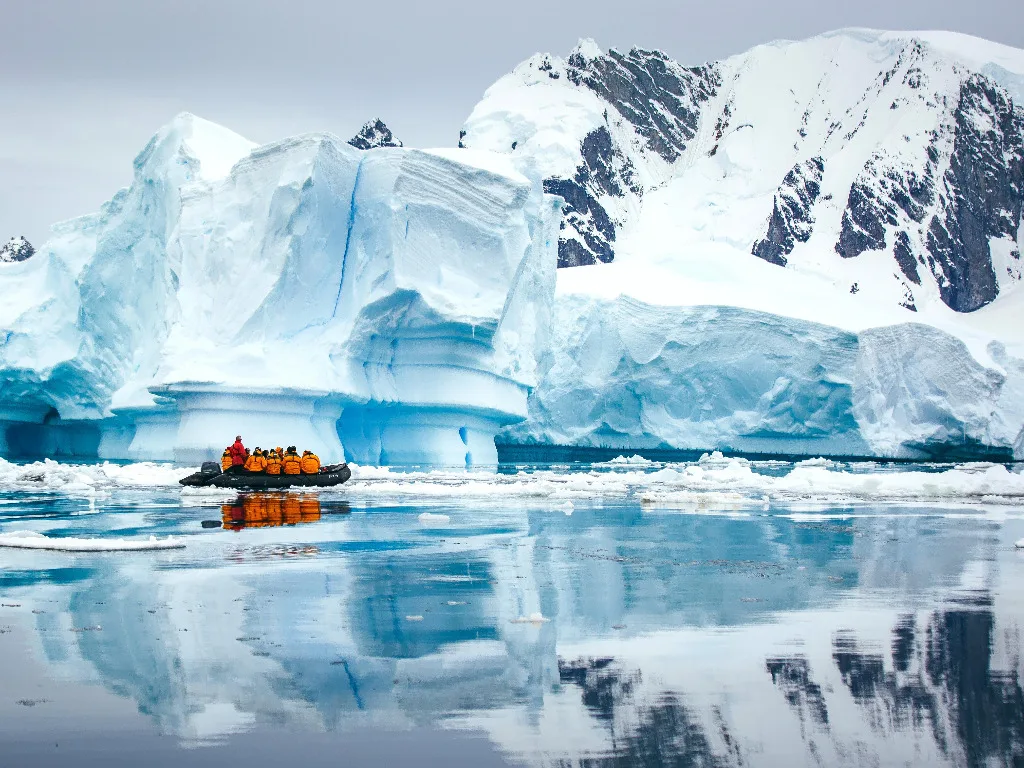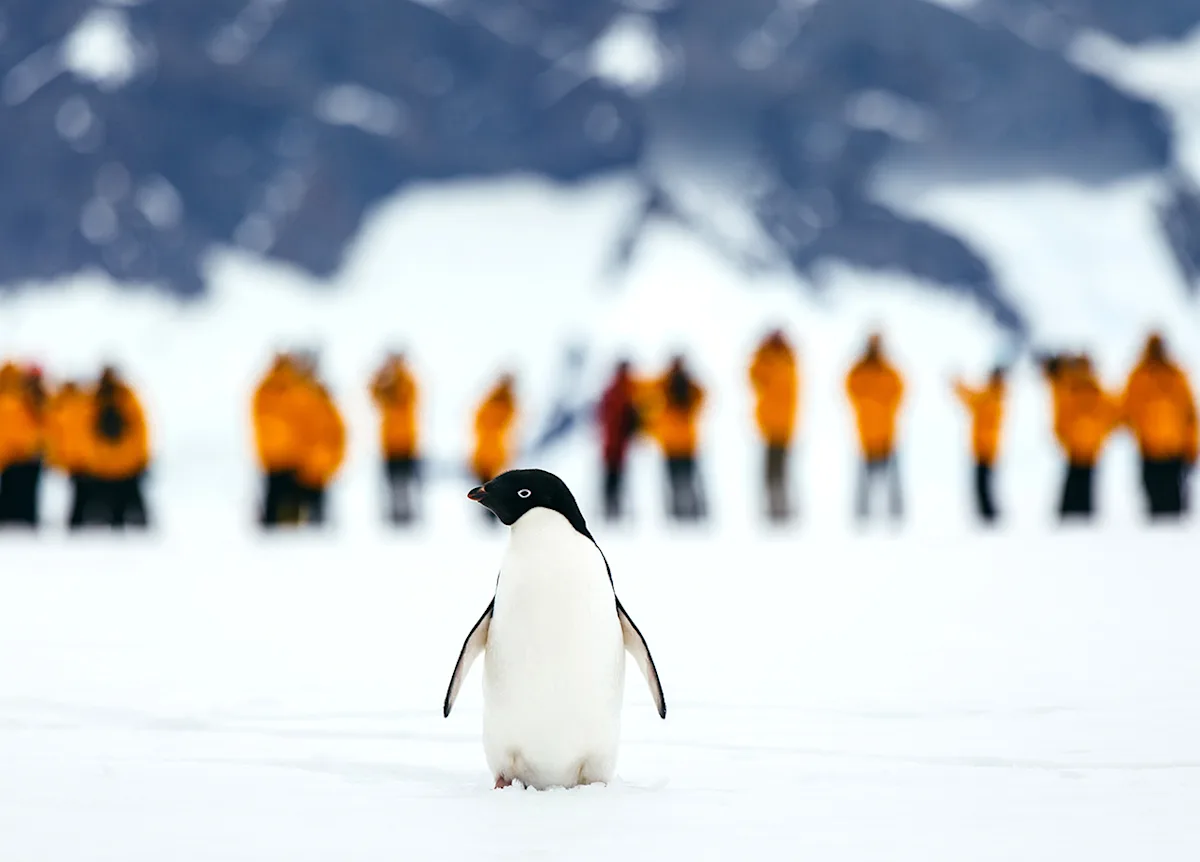
Curator’s statement
Embarking on a cruise or expedition to Antarctica promises a journey into the heart of pristine wilderness and unparalleled natural beauty. Beyond the allure of icebergs and glaciers, this frozen continent offers a rare glimpse into a fragile ecosystem teeming with diverse wildlife, from penguins and seals to whales. Whether you're drawn to the thrill of exploration or seeking solace in the serene landscapes, Antarctica captivates with its untouched splendor and unique experiences.
The Fora Difference
Book with Gillian to access exclusive perks and experiences on your trip.
Killer perks
Free upgrades, spa credits and more—we got you
Personalized recs
Customized travel planning for your style
Insider knowledge
Expert advice from people who’ve actually been there
Where to stay in Antartica
Unlock perks by contacting Gillian to book your trip.

Embarking on a cruise to Antarctica offers adventurers a chance to explore one of the last true wildernesses on Earth. From close encounters with penguins and seals to marveling at towering glaciers, every moment is filled with awe and wonder. Whether you're a nature enthusiast or simply seeking an unforgettable journey, Antarctica promises an expedition like no other.
When booking an Antarctic cruise, there are several important considerations to keep in mind:
Itinerary & activities: Review the cruise itinerary carefully to ensure it includes the destinations and activities you're interested in, such as wildlife viewing, shore landings, and specific Antarctic sites.
Cruise duration: Antarctic cruises can vary in length from a week to several weeks. Choose a duration that fits your schedule and allows ample time to explore.
Cruise type: Decide between expedition-style cruises — typically smaller ships with more adventurous itineraries and activities — or luxury cruises — larger ships with more amenities and comfort.
Ship size & facilities: Consider the size of the ship and its facilities. Smaller ships can often access more remote areas and offer a more intimate experience, while larger ships may provide more onboard amenities.
Expertise of crew & guides: Look for cruises with experienced expedition leaders, naturalists and guides who can enhance your experience with their knowledge of Antarctic wildlife, history and geology.


Safety & expedition equipment: Ensure the cruise provides adequate safety measures, including emergency protocols, as well as expedition equipment like Zodiac boats for shore landings.
Environmental responsibility: Choose a cruise operator committed to environmental stewardship and sustainable practices in Antarctica, minimizing their impact on the fragile ecosystem.
Budget: Antarctic cruises vary widely in cost depending on the ship, itinerary and season. Consider your budget and what is included, like meals, excursions and equipment.
Season & weather: Antarctica's climate varies greatly by season. Decide whether you prefer the milder temperatures and longer daylight hours of the Antarctic summer (November to March) or the pristine ice conditions and potential for wildlife sightings in early season (October) or late season (March).
Booking Policies: Understand the booking terms and cancellation policies, as well as any required travel insurance or medical requirements for the cruise.


By carefully considering these factors, you can choose an Antarctic cruise that matches your interests, budget and expectations, ensuring a memorable and enriching experience in this remote and spectacular part of the world.
Antarctic cruises typically depart from several key locations, depending on the cruise itinerary and operator:
Ushuaia, Argentina: This is the most common departure port for Antarctic cruises. Located at the southern tip of Argentina in Tierra del Fuego, Ushuaia is often referred to as the "Gateway to Antarctica." Cruises departing from Ushuaia usually cross the Drake Passage to reach the Antarctic Peninsula.
Punta Arenas, Chile: Some cruises depart from Punta Arenas, which is also situated in southern Chile. Cruises from Punta Arenas may travel to the western side of the Antarctic Peninsula or across the Drake Passage to the South Shetland Islands.
Puerto Madryn, Argentina: A few expeditions depart from Puerto Madryn, a city on Argentina's eastern coast. These cruises typically head to the Antarctic Peninsula or the Falkland Islands (Malvinas) before reaching Antarctica.
Stanley, Falkland Islands: For expeditions that include the Falkland Islands, Stanley serves as a departure point. From the Falklands, cruises may continue southward to South Georgia and Antarctica.
Cape Town, South Africa: Some longer Antarctic cruises depart from Cape Town, South Africa, offering a route that includes stops at South Georgia and the South Sandwich Islands before reaching Antarctica.
The choice of departure port often depends on the specific itinerary, the operator, and the desired route through the Southern Ocean towards Antarctica. Each departure location offers unique advantages in terms of the cruise itinerary and the landscapes you'll encounter along the way.
Here are some top companies known for Antarctic cruises, each offering unique experiences and amenities:
Quark Expeditions: Quark Expeditions specializes in polar expeditions, including Antarctic cruises that emphasize adventure and exploration. They operate small expedition ships equipped for polar conditions, offering activities like kayaking, camping and photography workshops. Quark is known for its experienced expedition team and commitment to sustainability.
Hurtigruten (HX): Hurtigruten — now known as HX — offers a range of expedition cruises to Antarctica aboard purpose-built expedition ships. They focus on providing immersive experiences with expert guides, onboard lectures and a variety of activities such as hiking and wildlife watching. HX emphasizes environmental responsibility and sustainability in its operations.
Silversea Expeditions: Silversea Expeditions offers luxury Antarctic cruises aboard small luxury expedition ships. They combine comfort with exploration, providing gourmet dining, spacious accommodations and a range of activities such as Zodiac cruising and guided shore excursions. Silversea is renowned for its high-end amenities and attentive service.
G Adventures: G Adventures offers small-group Antarctic cruises focused on sustainable travel and authentic experiences. They operate expedition ships equipped for polar conditions and emphasize educational opportunities, community engagement, and active exploration. G Adventures promotes responsible tourism practices and local partnerships.
These companies are recognized for their commitment to providing safe, informative and memorable Antarctic cruise experiences tailored to various interests and preferences, from adventure and exploration to luxury and sustainability.
The ideal length for an Antarctic cruise depends on your preferences, budget, and the type of experience you're seeking. Here are some considerations for different cruise lengths:
Short cruises (6-10 days): These cruises typically focus on exploring the Antarctic Peninsula. They're ideal if you have limited time or prefer a more compact expedition experience. You'll likely visit several landing sites and have opportunities for wildlife viewing and scenic cruising.
Medium-length cruises (11-15 days): These cruises offer a more comprehensive exploration of the Antarctic Peninsula and may include visits to nearby islands like South Georgia or the Falkland Islands. This length allows for a deeper immersion in Antarctic landscapes and wildlife.
Longer cruises (16+ days): Longer cruises often combine Antarctica with visits to South Georgia, the Falkland Islands or even the Antarctic Circle. They offer extensive wildlife encounters, historical explorations and the chance to explore remote regions less frequented by tourists.
The choice of cruise length also affects your overall experience onboard. Shorter cruises may feel more rushed but are suitable for those with limited vacation time, while longer cruises provide more opportunities for in-depth exploration and wildlife sightings.
Ultimately, the ideal length for an Antarctic cruise is subjective and depends on your interests, budget and availability. It's essential to carefully review the itineraries offered by different cruise operators to find one that aligns with your preferences and allows you to make the most of your Antarctic adventure.
An Antarctic cruise is ideal for anyone with a sense of adventure and a love for nature and wildlife. Specifically, it appeals to:
Nature enthusiasts: Those who appreciate the pristine beauty and unique ecosystems of remote wilderness areas.
Wildlife lovers: People interested in observing and photographing diverse wildlife such as penguins, seals, whales and seabirds in their natural habitats.
History buffs: Individuals fascinated by the history of Antarctic exploration and interested in visiting historic sites like research stations and whaling stations.
Photographers: Photographers of all levels who seek to capture stunning landscapes, wildlife and unique ice formations found only in Antarctica.
Adventurers: Those who enjoy outdoor activities such as hiking, kayaking and Zodiac cruising in challenging and remote environments.
Educational travelers: Students, educators and lifelong learners interested in gaining firsthand knowledge about climate change, polar science, and environmental conservation efforts in Antarctica.
Cultural explorers: Travelers interested in visiting indigenous communities in Antarctica or learning about the diverse cultural heritage associated with Antarctic exploration.
While Antarctic cruises cater to a range of interests and activity levels, it's important to note that they involve travel to a remote and challenging environment. Participants should be prepared for variable weather conditions, potential seasickness and physical activities associated with shore landings and exploration. Overall, an Antarctic cruise offers a once-in-a-lifetime experience for those seeking to explore one of the last true wilderness areas on Earth.
The best time to go on an Antarctic cruise depends on your preferences for wildlife sightings, weather conditions, and activities. Generally, there are two main Antarctic cruise seasons:
Antarctic Summer (November to March):
Peak season: December to February is considered the peak season due to milder temperatures, longer daylight hours and more stable weather conditions.
Wildlife: This time offers the best chances to see wildlife such as penguins, seals and whales, as they are most active during the summer months.
Activities: You can enjoy activities like shore landings, kayaking and camping on the Antarctic Peninsula and nearby islands.
Shoulder Seasons (late October and March):
Early Season (late October to November): This period offers pristine ice conditions and the chance to see nesting penguins and seals giving birth.
Late Season (late February to March): This time is ideal for whale watching as whales migrate south for feeding.
Factors to consider:
Weather: Conditions can be more unpredictable earlier in the season, with potentially rougher seas and colder temperatures.
Ice conditions: Earlier in the season, you may encounter more sea ice, which can impact accessibility to certain areas.
On an Antarctic cruise, you can expect to see:
Penguins: Various species like Adélie, Gentoo and Chinstrap penguins abound on the Antarctic Peninsula.
Seals: Look out for Weddell seals, Leopard seals and the impressive Southern elephant seals lounging on ice floes.
Whales: Witness magnificent whales such as Humpback whales, Orcas and Minke whales breaching and feeding in Antarctic waters.
Icebergs: Massive and sculptural icebergs, often in striking blue hues, dot the Antarctic seascape.
Glaciers: Marvel at towering glaciers calving into the ocean, creating dramatic splashes and ice formations.
Birds: Spot a variety of seabirds, including Albatrosses, Petrels and Sheathbills soaring above the icy waters.
Historic sites: Visit former research stations and historic huts that tell the story of Antarctic exploration.
Ice-covered landscapes: Experience the breathtaking beauty of Antarctica's vast ice-covered landscapes and snow-capped mountains.
Sunsets & sunrises: Witness stunning sunsets and sunrises over the Antarctic horizon, often painted in vibrant colors against the ice and sea.
Remote Wilderness: Immerse yourself in one of the last true wilderness areas on Earth, where nature reigns supreme and human impact is minimal.
These sights collectively offer an unforgettable glimpse into the raw beauty and unique ecosystem of Antarctica, making it a bucket-list destination for nature enthusiasts and adventurers alike.
On an Antarctic cruise, you can participate in a variety of exciting excursions that allow you to explore this unique continent up close. Some common excursions include:
Zodiac Cruises: These small inflatable boats allow you to cruise among icebergs and get close to wildlife along the shoreline. They're perfect for photography and intimate wildlife encounters.
Shore Landings: Weather-permitting, shore landings are opportunities to step foot on Antarctic soil. You can explore penguin rookeries, visit historic sites like research stations or whaling stations, and hike across pristine landscapes.
Wildlife watching: Antarctic cruises offer ample opportunities for wildlife watching. You can observe penguins, seals and seabirds in their natural habitats from the deck of the ship or during Zodiac excursions.
Kayaking: Many Antarctic cruises offer kayaking excursions, allowing you to paddle through icy waters and get even closer to wildlife and icebergs. It's a serene way to experience the Antarctic environment.
Polar plunges: For the adventurous, some cruises offer the chance to take a "polar plunge" into the frigid Antarctic waters, often accompanied by cheers from fellow passengers and crew.
Lectures & presentations: Expedition teams on board often provide lectures and presentations on Antarctic wildlife, history, geology and climate. These educational sessions enrich your understanding of the region.
Photography workshops: Professional photographers on board may offer workshops to help you capture the stunning Antarctic landscapes and wildlife through your camera lens.
Citizen science programs: Some cruises engage passengers in citizen science projects, such as whale or bird identification, contributing valuable data to ongoing research efforts.
These excursions cater to a range of interests and activity levels, ensuring that everyone onboard has the opportunity to fully immerse themselves in the awe-inspiring beauty and unique experiences that Antarctica offers.
Packing for an Antarctic cruise requires careful consideration due to the extreme and unpredictable weather conditions. Here's a comprehensive list of items you should consider bringing:
Clothing:
Insulating Layers: Thermal underwear, fleece jackets or sweaters, and insulated pants.
Waterproof Outer Layers: Waterproof jacket and pants to protect against wind, rain and snow.
Base Layers: Moisture-wicking base layers — tops and bottoms — to manage sweat and keep you dry.
Gloves and Hats: Thermal gloves or mittens and a warm hat or beanie to protect against cold winds.
Footwear:
Waterproof Boots: High-quality, insulated waterproof boots designed for cold and wet conditions. These are essential for shore landings.
Accessories:
Sunglasses: Polarized sunglasses to protect against the bright Antarctic sun and glare from snow and ice.
Sunscreen: High-SPF sunscreen for face and lips, as UV rays can be strong even in Antarctica.
Daypack: A small backpack to carry essentials during excursions.
Binoculars: Lightweight, waterproof binoculars for wildlife watching.
Miscellaneous:
Camera Equipment: Extra batteries, memory cards and a sturdy camera bag to protect equipment from moisture.
Dry bag or waterproof case: To protect electronics and other sensitive items during Zodiac rides.
Personal medications: Any prescription medications you may need, as well as seasickness medication if you are prone to motion sickness.
Travel insurance documents: Carry copies of your travel insurance policy and emergency contact information.
Reusable water bottle: To stay hydrated with fresh water provided on the ship.
Electrical Adapter: Depending on the cruise ship's electrical outlets, an adapter may be necessary for charging devices.
Optional Items:
Books or journal: To capture memories or pass time during leisure hours.
Snacks: Energy bars or snacks to supplement meals provided on board.
Deck shoes or slippers: Comfortable shoes or slippers for wearing indoors on the ship.
Remember that packing light and efficiently is key, as space may be limited in cabins. Many Antarctic cruises also provide expedition gear such as waterproof pants and parkas, which can reduce the amount you need to pack. Always check with your cruise operator for specific packing recommendations tailored to your voyage.
Frequently-asked questions
When is the best time to go on an Antarctic cruise?
The best time is during the Antarctic summer, from November to March. December to February is peak season with milder temperatures, longer daylight hours and optimal wildlife viewing opportunities.
What wildlife can I see on an Antarctic cruise?
You can see a variety of wildlife, including penguins — Adélie, Gentoo, Chinstrap— and seals — Weddell, Leopard, Southern elephant — and whales — Humpback, Orca, Minke — along with numerous seabird species.
What should I pack for an Antarctic cruise?
Pack warm, waterproof clothing including thermal layers, waterproof jacket and pants, insulated boots, sunglasses, sunscreen and essential personal items like medications and camera gear.
How rough is the Drake Passage?
The Drake Passage can vary from calm to rough seas. It's advisable to be prepared for motion sickness and follow guidance from experienced crew members regarding coping strategies.
Are Antarctic cruises safe?
Antarctic cruises are generally safe with experienced crew, stringent safety protocols and well-equipped ships designed for polar conditions. Emergency drills and procedures are standard.
What activities are available on an Antarctic cruise?
Activities typically include shore landings for wildlife viewing and exploration, Zodiac cruising among icebergs, kayaking, photography workshops, lectures and occasionally camping on shore.
Do I need a visa for Antarctica?
No visa is required for Antarctica itself, as it has no government and no permanent population. However, visas may be required for entry to countries like Argentina or Chile, depending on your itinerary.
What is the accommodation like on an Antarctic cruise?
Accommodations range from comfortable cabins with private facilities on luxury ships to more basic but cozy options on expedition vessels. Most ships offer amenities suitable for polar conditions.
How long are Antarctic cruises?
Antarctic cruises vary in length from around six days to over 20 days, depending on the itinerary. Shorter cruises focus on the Antarctic Peninsula, while longer cruises may include South Georgia, the Falklands or the Antarctic Circle.
What is the cost of an Antarctic cruise?
Costs vary widely based on cruise duration, ship type — luxury vs. expedition, cabin category and included amenities. Prices typically range from several thousand to tens of thousands of dollars per person. Additional expenses may include flights, pre-trip accommodations and optional activities.
Before an Antarctic cruise, you can explore your departure city and nearby attractions. Here are some ideas depending on where your cruise departs from:
Ushuaia, Argentina:
Visit Tierra del Fuego National Park for hiking and scenic views.
Explore the End of the World Museum to learn about local history and indigenous cultures.
Take a boat tour of the Beagle Channel to see wildlife like sea lions and seabirds.
Punta Arenas, Chile:
Visit the historic Plaza Muñoz Gamero and explore the colonial architecture.
Take a day trip to Magdalena Island to see a large colony of Magellan penguins.
Visit the Museo Nao Victoria to see replicas of historic ships.
Cape Town, South Africa:
Visit Table Mountain for panoramic views of the city and coastline.
Take a boat trip to Robben Island to learn about its history as a political prison.
Explore the vibrant Victoria & Alfred Waterfront for shopping, dining, and entertainment.
If you’re up for additional adventures after your cruise, here are some great starting points:
Explore Patagonia:
Extend your trip to visit Torres del Paine National Park in Chile or Los Glaciares National Park in Argentina for stunning landscapes and hiking opportunities.
Visit Buenos Aires, Argentina:
Experience the vibrant culture of Argentina's capital city with tango shows, historic neighborhoods like La Boca and San Telmo, and world-class dining.
Explore Santiago, Chile:
Discover Chilean culture and history with visits to museums, parks, and nearby vineyards in the Maipo Valley for wine tasting.
Extend to Rapa Nui (Easter Island):
Visit the mysterious moai statues and enjoy the Polynesian culture on this remote island in the Pacific Ocean.
These pre- and post-trip activities can enhance your Antarctic cruise experience by providing cultural immersion, additional wildlife encounters and exploration of diverse landscapes beyond the frozen continent.
Need to know
A cruise or expedition to Antarctica isn't just a journey; it's a transformative experience that immerses you in a world of icy wonders and abundant wildlife. Whether you choose a luxury cruise or an adventurous expedition, the memories of exploring vast icebergs and encountering unique species will stay with you forever. Antarctica beckons as a testament to nature's grandeur and a reminder of the importance of preserving our planet's most fragile environments for future generations.
This trip report is part of our ongoing series on travel to Antarctica. In need of further inspiration? Check out Gillian Spatz's guide, Exploring Malibu: A Seaside Escape Guide for the Adventure Enthusiast.

Travel Advisor
Gillian Spatz

Get in touch with Gillian
Did you like this guide? Reach out to customize and book your own experience. Or, just to chat about travel in general.
You can normally expect a response from Gillian within a business day or so. You’ll also be subscribed to our travel newsletter (you can unsubscribe at any time).